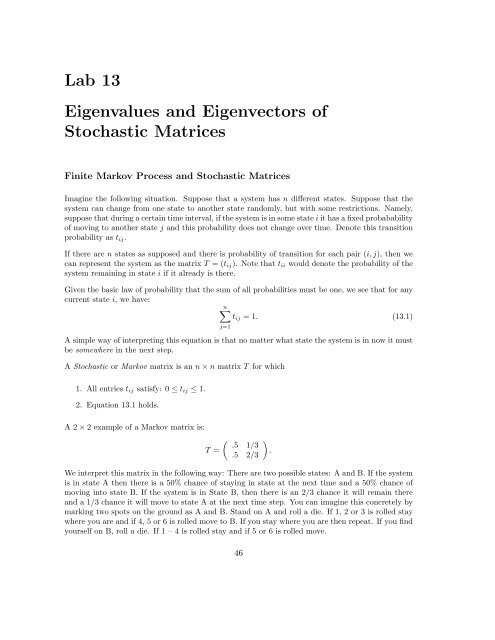Introduction to Numerical Math and Matlab ... - Ohio University
Introduction to Numerical Math and Matlab ... - Ohio University
Introduction to Numerical Math and Matlab ... - Ohio University
You also want an ePaper? Increase the reach of your titles
YUMPU automatically turns print PDFs into web optimized ePapers that Google loves.
Lab 13<br />
Eigenvalues <strong>and</strong> Eigenvec<strong>to</strong>rs of<br />
S<strong>to</strong>chastic Matrices<br />
Finite Markov Process <strong>and</strong> S<strong>to</strong>chastic Matrices<br />
Imagine the following situation. Suppose that a system has n different states. Suppose that the<br />
system can change from one state <strong>to</strong> another state r<strong>and</strong>omly, but with some restrictions. Namely,<br />
suppose that during a certain time interval, if the system is in some state i it has a fixed probabability<br />
of moving <strong>to</strong> another state j <strong>and</strong> this probability does not change over time. Denote this transition<br />
probability as t ij .<br />
If there are n states as supposed <strong>and</strong> there is probability of transition for each pair (i, j), then we<br />
can represent the system as the matrix T = (t ij ). Note that t ii would denote the probability of the<br />
system remaining in state i if it already is there.<br />
Given the basic law of probability that the sum of all probabilities must be one, we see that for any<br />
current state i, we have:<br />
n∑<br />
t ij = 1. (13.1)<br />
j=1<br />
A simple way of interpreting this equation is that no matter what state the system is in now it must<br />
be somewhere in the next step.<br />
A S<strong>to</strong>chastic or Markov matrix is an n × n matrix T for which<br />
1. All entries t ij satisfy: 0 ≤ t ij ≤ 1.<br />
2. Equation 13.1 holds.<br />
A 2 × 2 example of a Markov matrix is:<br />
T =<br />
( .5 1/3<br />
.5 2/3<br />
We interpret this matrix in the following way: There are two possible states: A <strong>and</strong> B. If the system<br />
is in state A then there is a 50% chance of staying in state at the next time <strong>and</strong> a 50% chance of<br />
moving in<strong>to</strong> state B. If the system is in State B, then there is an 2/3 chance it will remain there<br />
<strong>and</strong> a 1/3 chance it will move <strong>to</strong> state A at the next time step. You can imagine this concretely by<br />
marking two spots on the ground as A <strong>and</strong> B. St<strong>and</strong> on A <strong>and</strong> roll a die. If 1, 2 or 3 is rolled stay<br />
where you are <strong>and</strong> if 4, 5 or 6 is rolled move <strong>to</strong> B. If you stay where you are then repeat. If you find<br />
yourself on B, roll a die. If 1 – 4 is rolled stay <strong>and</strong> if 5 or 6 is rolled move.<br />
46<br />
)<br />
.
















